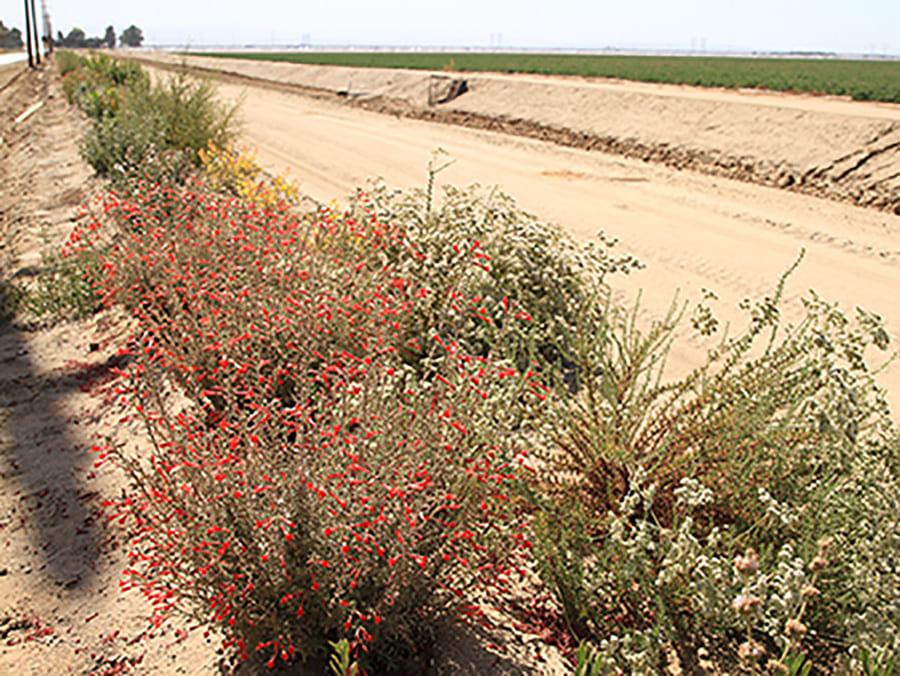A study published today in the science journal PLoS ONE finds that planting the margins of agricultural fields with pollinator-friendly plants and minimizing pesticide use in the Central Valley of California could help pollinators survive in this highly altered landscape.
Pollinators are vital for agricultural production and for maintaining intact ecosystems. More than 85% of flowering plants require an animal, mostly insects, to move pollen, and one in three mouthfuls of food we consume come from an insect pollinator. Unfortunately, pollinators are rapidly declining. The United Nations Intergovernmental Science-Policy Platform on Biodiversity and Ecosystem Services assessment found that greater than 40% of invertebrate pollinator species may be facing extinction, particularly bees and butterflies.
“Insects populations and the pollinating services that they provide are decreasing at alarming rates across the globe,” Tom Dilts, a spatial analyst and research scientist at the University of Nevada, Reno’s College of Agriculture, Biotechnology and Natural Resources said. “Our paper addresses how the restoration of agricultural margins and reductions in pesticide use can greatly improve connectivity for pollinating insects in the Central Valley. We use a modeling approach that looks at three different agricultural margin scenarios combined with three different pesticide use scenarios."
Dilts and his colleague Matt Forister in the University's College of Science have collaborated with the Xerces Society for Invertebrate Conservation on the project. The Xerces Society is actively engaged in habitat enhancement projects throughout California’s Central Valley and they helped design the study, and participated in the resulting PLoS ONE article, "Agricultural margins could enhance landscape connectivity for pollinating insects across the Central Valley of California, U.S.A."
Pollinators need high-quality, connected habitats to move across landscapes in search of new habitats and as a refuge from a changing climate. Improving habitat connectivity enables pollinators to move among populations, increasing genetic diversity and helping to prevent populations from becoming too small.
The Central Valley was once dominated by native grasslands, wetlands, and river and floodplain habitat but most of this habitat has been lost. Many farm properties in California contain little or no natural habitat, and where patches of pollinator habitat remain, they tend to be isolated. Pesticides – including highly toxic, systemic, long-lived insecticides – are also pervasive on many farms and in cities and towns.
To determine the best way to provide habitat connectivity for pollinators in the Central Valley, scientists from the University of Nevada at Reno and the Xerces Society for Invertebrate Conservation developed a tool for modeling landscape connectivity for insects – with pollinators in particular in mind – that uses land use information, lethality of pesticides and expert opinion on insect movement.
“Using our modeling approach, we found that agricultural margins have the potential to greatly enhance habitat connectivity for pollinating insects,” Dilts, in his college's Department of Natural Resources and Environmental Science, said. “Our study is unique because it considers pesticide application rates to estimate limitations to movement for pollinating insects.”
Agricultural areas have often suffered the most severe declines in pollinator abundance, yet these areas need pollinators and other beneficial insects to ensure agricultural productivity. The Central Valley produces 25% of the country’s food and 40% of its fruits and nuts. The value of pollination services from wild pollinators to California agriculture is between $937 million and $2.4 billion per year.
The connectivity modeling suggested higher resistance to insect movement in the inner region of intensive cropping in the Central Valley, particularly in the southern areas of the San Joaquin Valley with greater acreage of crops with high pesticide inputs, such as citrus. In addition to restoring habitat in agricultural margins, reducing pesticide loads in these areas has the potential to increase connectivity for pollinators: the models indicated that the number of least-cost paths across the Central Valley for pollinators increased by 10% as pesticide use decreased
“Restoring habitat connectivity to provide for pollinating insects is critical for preventing biodiversity collapse, providing natural pollination services, and preventing extinction,” said Scott Black, Executive Director of the Xerces Society for Invertebrate Conservation. “This modeling shows that if we maximize field edge plantings with diverse native plants and minimize pesticide use, we can both improve pollinator survival and protect our future crops and food supply.”
Beyond allowing pollinators to move across the landscape, restored and enhanced field borders can also provide substantial areas of habitat. The study found that over 1 million acres of habitat could be added to the Central Valley by restoring drainage ditches, field edges and uncultivated borders.
Farmers who plant hedgerows at their field edges will see more benefits than just returning pollinators. This habitat can also attract insects that are beneficial for pest control, provide habitat for birds and other wildlife and minimize soil erosion. Additionally, USDA offers cost share conservation programs that allow for a quicker return on investment for a hedgerow or other type of habitat planting.
Despite the massive fragmentation of the Central Valley, the study found that connectivity is possible, especially utilizing the restoration or improvement of agricultural margins, which (in their summed area) exceed natural areas in the most extensively cultivated parts of the Central Valley.
“Many studies have shown that restoring hedgerows and other habitat along agricultural margins can be valuable for many beneficial insects – from pollinators to predators of crop pests,” said Matt Forister, Trevor J. McMinn Endowed Professor in Biology, at the University of Nevada Reno. “This study suggests that these areas might also be used to enhance the movement of pollinators across the landscape to find new habitats, which we expect to become of increasing importance with accelerating impacts of climate change.”















